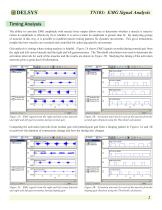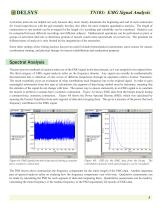
Catalog excerpts

Technical Note 103: EMG Signal Analysis Purpose This technical note addresses the main classes of EMG analysis. It assumes that quality EMG data has already been acquired. Please see Technical Note 101: EMG Sensor Placement and Technical Note 102: EMG Signal Quality for more details. • Amplitude Analysis • Timing Analysis • Spectral Analysis Surface EMG Concepts • EMG Amplitude and Muscle Force • Activation Intervals • Fatigue Software Concepts • • • • www.delsys.com Root Mean-Square Threshold Power Spectral Density Mean and Median Frequency 617 236 0599 (Tel)
Open the catalog to page 1
Introduction This document is one of a series of technical notes designed to address important concepts dealing with Delsys® hardware and software. The goal of this technical note is to introduce the three main classes of EMG signal analysis. These fundamental techniques have classically yielded the most insight into the EMG signal. Some example applications for each type of analysis will also be discussed. Amplitude Analysis The amplitude of the EMG signal at any instant in time is stochastic or random. In most circumstances, however, visual inspection of the gross EMG signal reveals that...
Open the catalog to page 2
Timing Analysis The ability to correlate EMG amplitude with muscle force output allows one to determine whether a muscle is inactive (when its amplitude is effectively 0) or whether it is active (when its amplitude is greater than 0). By analyzing groups of muscles in this way, it is possible to establish muscle timing patterns for dynamic movements. This gives tremendous insight into how muscles are recruited and controlled for achieving specific movements. Gait analysis is setting where timing analysis is helpful. Figure 2A shows EMG signals recorded during normal gait from the right and...
Open the catalog to page 3
Activation intervals are helpful not only because they more clearly demarcate the beginning and end of each contraction for visual inspection as with the gait example, but they also allow for more complex quantitative analysis. The length of contractions or rest periods can be averaged for the length of a recording and variability can be examined. Statistics can be compared between different recordings and different subjects. Mathematical operations can be performed on pairs or groups of activation intervals to determine periods of muscle coactivation and periods of overall rest. The...
Open the catalog to page 4
The most important application of spectral analysis is the study of muscle fatigue. It has been shown that the mean and median frequencies of the EMG signal decrease with time during a task that induces fatigue. Figure 5A shows the median frequency calculated as a function of time for the data from the biceps. Figure 5B shows a curve fit to this data to quantify the decrease in median frequency with time. Figure 5A: Median frequency of the biceps EMG data as a function of time. Figure 5B: Median frequency of the biceps EMG data as a function of time along with a curvefit to quantify the...
Open the catalog to page 5All Delsys catalogs and technical brochures
-
EMG Signal Quality
6 Pages
-
EMG Sensor Placement
10 Pages
-
Delsys Product Catalog (2021)
19 Pages





